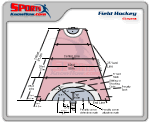Field Hockey Field Dimensions Diagram
Field Hockey Field Dimensions
Any official field hockey game governed by the International Hockey Federation (IHF) is played on a synthetic surface called turf. Grass is rarely used for national and international games these days, although small local hockey clubs may still use this surface.
The hockey field, also called pitch is a standard size around the world and includes basic markings. Markings should be drawn in white and as solid lines or arcs, with a width of 3 inches (0.075 meter) which is already factored into the measurements given below.
Dimensions and Markings for the Field Hockey Pitch
Pitch boundary:
The pitch on which field hockey is played has a length of 299 feet, 10 inches (91.4 meters) and a width of 180 feet, 5 inches (55.0 meters). This boundary is marked on the turf and the shorter lines are called backlines.
Centerline:
A straight line is drawn midway between the backlines, and parallel to them. This centerline divides the pitch into two equal parts.
25-yard line:
In each half, another parallel line is drawn at a distance of 75 feet, 2 inches (22.9 meters) from the backline. This distance converts to 25 yards, hence this is called the 25-yard line. Now the pitch is divided into four equal parts.
Striking circle or “D”:
From the center of each backline, a point is marked 6 feet (1.8 meters) away and a quarter-circle arc having a radius of 48 feet (14.6 meters) is drawn from here on the inside of the field. The two quarter-circles are joined at the top by a straight line measuring 12 feet (3.7 meters) to form the D-shaped striking circle, also referred to as the “D”. Another set of quarter circles are drawn outside these and 18 feet, 1 inch (5.5 meters) away. These arcs are not solid, but dashed.
Penalty Spot:
From the center of the baseline, this point is marked 21 feet (6.4 meters) towards the inside of the pitch with a width of 6 inches (0.2 meter).
Penalty Corner Defender’s and Attacker’s Marks:
At 16 feet, 5 inches (5.0 meters) and 32 feet, 10 inches (10.0 meters) away from the center of each backline in either direction, a line having a length of 1 foot (0.3 meter) is drawn. Thus, each backline will have four such markings. These are known as the penalty corner defender’s and attacker’s marks, respectively.
Long Corner Attacker’s Mark:
Along each sideline at 16 feet, 5 inches (5.0 meters) from the backline, a line 1 foot (0.3 meter) long is drawn to form this mark.
Dimensions and Specifications for the Goal Area
Goal Post:
Each goal post has a height of 7 feet (2.14 meters) and a width of 2 inches (0.05 meter). These posts are white.
Goal:
Each post is placed 6 feet (1.83 meters) away from the center of the backline, one on either side, with a depth of 4 feet (1.2 meters). This makes the total goal width 12 feet (3.66 meters).
Sideboards and Blackboards:
These have a height of 1 foot, 6 inches (0.5 meter) from the ground. The backboard runs the length of the goal and is 12 feet (3.66 meters) across. The sideboard depth is 4 feet (1.20 meters) at ground level and both are placed in parallel for each goal, perpendicular to the backboard. The color of the backboard and sideboards should be darker than that of the pitch.
Net:
The black net consists of mesh whose spacing should not exceed 1.6 inches (0.04 meter). It is fixed to the goal posts, bar, sideboards and backboard at intervals of 6 inches (0.15 meter) or less, to form netting around the top, sides and back of the goal. This net should not be fixed too taut; this is to stop the ball that is hit into the goal from rebounding off the net.
